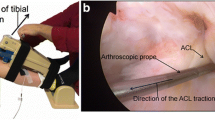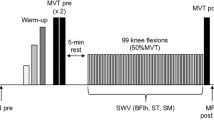Abstract
Rupture of the anterior cruciate ligament (ACL) is one of the most serious sports-related injuries and requires long recovery time. The quadriceps and hamstring muscles are functionally important to control stability of the knee joint complex. Fatigue, however, is an important factor that may influence stabilizing control and thus cause ACL injuries. The objective of this study was therefore to assess how submaximal fatigue exercises of the hamstring muscles affect anterior tibial translation as a direct measure of knee joint stability. While 15 test participants were standing upright with the knees in 30° of flexion, anterior tibial translation was induced by a force of 315 N. Two linear potentiometers placed on the tibial tuberosity and the patella recorded tibial motion relative to the femur. Reflex latencies and neuromuscular hamstring activity were determined using surface electromyography (EMG). Muscle fatigue produced a significant longer latency for the monosynaptic reflex latencies, whereas no differences in the latencies of the medium latency component were found. Fatigue significantly reduced EMG amplitudes of the short and medium latency components. These alterations were in line with significantly increased anterior tibial translation. Our results suggest that hamstring fatigue is effectively associated with mechanical loss of knee stability. This decrease in joint stability may at least in part explain higher risk of ACL injury, especially in fatigued muscles. Furthermore, we discuss why the present findings indicate that reduced motor activity rather than the extended latency of the first hamstring response is the reason for possible failure.





Similar content being viewed by others
References
Avela J, Komi PV (1998) Reduced stretch reflex sensitivity and muscle stiffness after long-lasting stretch-shortening cycle exercise in humans. Eur J Appl Physiol Occup Physiol 78:403–410
Avela J, Kyrolainen H, Komi PV, Rama D (1999) Reduced reflex sensitivity persists several days after long-lasting stretch-shortening cycle exercise. J Appl Physiol 86:1292–1300
Beard DJ, Kyberd PJ, Ferguson CM, Dodd CA (1993) Proprioception after rupture of the anterior cruciate ligament. An objective indication of the need for surgery? J Bone Joint Surg 75:311–315
Beard DJ, Kyberd PJ, O’Connor JJ, Ferguson CM, Dodd CA (1994) Reflex hamstring contraction latency in anterior cruciate ligament deficiency. J Orthop Res 12:219–228
Bigland-Ritchie BR, Furbush F, Woods JJ (1986) Fatigue of intermittent submaximal voluntary contractions: central and peripheral factors. J Appl Physiol 61:421–429
Bongiovanni LG, Hagbarth K-E (1990) Tonic vibration reflexes elicited during fatigue from maximal voluntary contractions in man. J Physiol 423:1–14
Bruhn S (1999) Functional knee stability. PhD Thesis, University of Stuttgart
Dhaher YY, Tsoumains AD, Houle TT, Rymer WZ (2005) Neuromuscular reflexes contribute to knee stiffness during valgus loading. J Neurophysiol 93:2698–2709
Dolmage T, Cafarelli E (1991) Role of fatigue during repeated submaximal contractions of human quadriceps muscle. Can J Physiol Pharmacol 69:1410–1415
Duchateau J, Hainaut K (1993) Behaviour of short and long latency reflexes in fatigued human muscles. J Physiol 471:787–799
Dyrhe-Poulsen P, Krogsgaard MR (2000) Muscular reflexes elicited by electrical stimulation of the anterior cruciate ligament in humans. J Appl Physiol 98:2191–2195
Freeman MA, Wyke B (1967) The innervation of the knee joint. An anatomical study and histological study in the cat. J Anat 101:505–532
Friemert B, Faist M, Spengler C, Gerngross H, Claes L, Melnyk M (2005) Intraoperative direct mechanical stimulation of the anterior cruciate ligament elicits short and medium latency hamstring reflexes. J Neurophysiol 94:3996–4001
Friemert B, Bumann-Melnyk M, Faist M, Schwarz W, Gerngross H, Claes L (2005) Differentiation of hamstring short latency and medium latency response of the hamstring after tibia translation. Exp Brain Res 160:1–9
Grana WA, Muse G (1988) The effect of exercise on laxity in the anterior cruciate ligament deficient knee. Am J Sports Med 16:586–588
Grey MJ, Ladouceur M, Andersen JB, Nielsen JB, Sinkjaer T (2001) Group II muscle afferents probably contribute to the medium latency soleus stretch reflex during walking in humans. J Physiol 534:925–933
Haus J, Halata Z (1990) Innervation of the anterior cruciate ligament. Int Orthop 14:293–296
Hawkins RD, Fuller CW (1998) An examination of the frequency and severity of injuries and incidents at three levels of professional football. Br J Sports Med 32:326–332
Hiemstra LA, Lo IK, Fowler PJ (2001) Effect of fatigue on knee proprioception: implications for dynamic stabilization. J Orthop Sports Phys Ther 31:598–605
Jerosch J, Prymka M (1996) Proprioception and joint stability. Knee Surg Sports Traumatol Arthrosc 4:171–179
Johansson H, Sjölander P, Sojka P (1990) Activity in receptors afferents from the anterior cruciate ligament evokes reflex effects on fusimotor neurones. Neurosci Res 8:54–59
Johansson H, Sjölander P, Sojka P (1991) A sensory role for the cruciate ligaments. Clin Orthop 268:161–178
Jones LA (1995) The senses of effort and force during fatiguing contractions. Adv Exp Med Biol 384:305–313
Kuitunen S, Avela J, Kyrölainen H, Nicol C, Komi PV (2002) Acute and prolonged reduction in joint stiffness in humans after exhausting stretch-shortening cycle exercise. Eur J Appl Physiol 88:107–116
Kuitunen S, Komi PV, Kyrolainen H (2002) Knee and ankle joint stiffness in sprint running. Med Sci Sports Exerc 34:166–173
Lattanzio PJ, Petrella RJ, Sproule JR, Fowler PJ (1997) Effects of fatigue on knee proprioception. Clin J Sport Med 7:22–27
Markolf KL, Graff-Radford A, Amstutz HC (1978) In vivo knee stability. A quantitative assessment using an instrumented clinical testing apparatus. J Bone J Surg 60A:664–674
McCloskey DI (1978) Kinesthetic sensibility. Physiol Rev 58:763–820
More RC, Karras BT, Neiman R, Fritschy D, Woo SL, Daniel DM (1993) Hamstrings—an anterior cruciate ligament protagonist. An in vitro study. Am J Sports Med 21:231–237
Mrachacz-Kersting N, Sinkjaer T (2003) Reflex and non-reflex torque responses to stretch of the human knee extensors. Exp Brain Res 151:72–81
Nelson DL, Hutton RS (1985) Dynamic and static stretch responses in muscle spindle receptors in fatigued muscle. Med Sci Sports Exerc 17:445–450
Nicol C, Komi PV, Horita T, Kyrolainen H, Takala TE (1996) Reduced stretch-reflex sensitivity after exhausting stretch-shortening cycle exercise. Eur J Appl Physiol Occup Physiol 72:401–409
Nyland JA, Caborn DN, Shapiro R, Johnson DL (1997) Fatigue after eccentric quadriceps femoris work produces earlier gastrocnemius and delayed quadriceps femoris activation during crossover cutting among normal athletic women. Knee Surg Sports Traumatol Arthrosc 5:162–7
Nyland JA, Shapiro R, Stine RL, Horn TS, Ireland ML (1994) Relationship of fatigued run and rapid stop to ground reaction forces, lower extremities kinematics, and muscle activation. J Orthop Sports Phys Ther 20:132–137
Shultz SJ, Carcia CR, Perrin DH (2004) Knee joint laxity affects muscle activation patterns in the healthy knee. J Electromyogr Kinesiol 14:475–483
Sjolander P, Johansson H, Sojka P, Rehnholm A (1989) Sensory nerve endings in the cat cruciate ligaments: a morphological investigation. Neurosc Lett 102:33–38
Skinner HB, Wyatt MP, Hodgon JA, Conard DW, Barrack RL (1986) Effect of fatigue on joint position sense of the knee. J Orthop Res 4:112–118
Solomonow M, Krogsgaard M (2001) Sensorimotor control of knee stability. A review. Scand J Med Sci Sports 11:64–80
Solomonow M, Baretta R, Zhou BH, Shoji H, Bose B, Beck C, D’Ambrosia R (1987) The synergistic action of the anterior cruciate ligament and thigh muscle in maintaining joint stability. Am J Sports Med 15:207–231
Steiner ME, Grana WA, Chillag K, Schelberg-Karnes E (1986) The effect of exercise on anterior–posterior knee laxity 14:24–29
Stoller DW, Markolf KL, Zager SA, Shoemaker SC (1983) The effects of exercise, ice and ultrasonography on torsional laxity of the knee. Clin Orthop 174:172–180
Tsepis E, Vagenas G, Giakas G, Georgoulis A (2004) Hamstring weakness as an indicator of poor knee function in ACL-deficient patients. Knee Surg Sports Traumatol Arthrosc 12:22–29
Tsuda E, Ishibashi Y, Okamura Y, Toh S (2003) Restoration of anterior cruciate ligament-hamstring reflex arc after anterior cruciate ligament reconstruction. Knee Surg Sports Traumtol Arthosc 11:63–67
Wojtys EM, Wylie BB, Huston LJ (1996) The effects of muscle fatigue on neuromuscular function and anterior tibial translation in healthy knees. Am J Sports Med 24:615–621
Wojtys EM, Huston LJ (1994) Neuromuscular performance in normal and anterior cruciate ligament-deficient lower extremities. Am J Sports Med 22:89–104
Wikstrom EA, Powers M, Tillman MD (2004) Dynamic stabilization time after isokinetic and functional fatigue. J Athl Train 39:247–253
Woo SL, Hollis JM, Adams DJ, Lyon RM, Takai S (1991) Tensile properties of the human femur-anterior cruciate ligament-tibia complex. The effects of specimen age and orientation. Am J Sports Med 19:217–225
Zhang LQ, Rymer WZ (2001) Reflex and intrinsic changes induced by fatigue of human elbow extensor muscle. J Neurophysiol 86:1086–1094
Zhang LQ, Nuber G, Butler J, Bowen M, Rymer WZ (1998) In vivo human knee joint dynamic properties as functions of muscle contraction and joint position. J Biomech 31:71–76
Zimny ML, Schutte M, Dabezies E (1986) Mechanoreceptors in the human anterior cruciate ligament. Anat Rec 214:204–209
Author information
Authors and Affiliations
Corresponding author
Rights and permissions
About this article
Cite this article
Melnyk, M., Gollhofer, A. Submaximal fatigue of the hamstrings impairs specific reflex components and knee stability. Knee Surg Sports Traumatol Arthrosc 15, 525–532 (2007). https://doi.org/10.1007/s00167-006-0226-3
Received:
Accepted:
Published:
Issue Date:
DOI: https://doi.org/10.1007/s00167-006-0226-3




